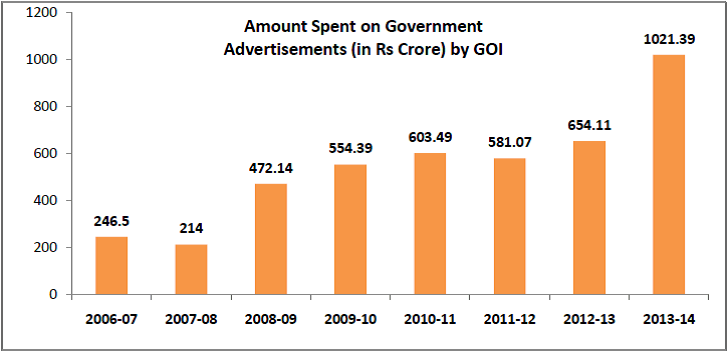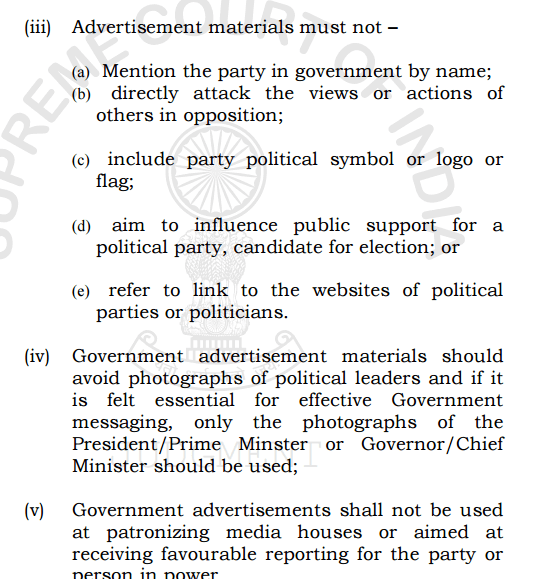[orc]We are all used to a barrage of government advertisements featuring photographs of Ministers & Politicians. The latest Supreme Court Judgement in a PIL filed by Common Cause & CPIL lays down some important guidelines to be followed while issuing government advertisements. The order now restricts using the photographs of any Minister or politician in government advertisements except that of the President of India, PM & CJI.
The Supreme Court dealt a body blow to the practice of using photographs of Ministers & Politicians in Government advertisements. In a landmark judgement, it laid down guidelines for government issued advertisements. The Union Government filed its objections about some of the items in the guidelines, but the court accepted only a couple of them rejecting the others.
Government Advertisements & Spending
Government advertisements are not new. These advertisements are meant to educate the citizens about the new schemes of the government, citizen’s rights, their entitlements, safety information, public health related information among other things. But in recent times, these have become tools for propaganda. The content and the amounts spent on advertisements often depend on the party in power. Each party tries to elevate political figures who are/were associated with their party while ignoring others. Government advertisements also have become tools to promote self & individuals thus encouraging a dangerous personality cult. Governments also spend heavily on the eve of election thus impacting a fair election process.
The Directorate of Advertising and Visual Publicity (DAVP) under the Ministry of Information & Broadcasting issues advertisements on behalf of all Government departments. State Governments route their advertisements through their Information & Public Relation Departments (I & PR). The spending on government advertisements has been increasing year on year in the last decade. In 2013-14, more than 1000 crore rupees were spent on government advertisements. This is only by the Central Government. State Governments spend in addition to this.
The Supreme Court Case
Common Cause and Centre for Public Interest Litigation, two registered bodies have filed a PIL under Article 32 of the Constitution seeking an order to restrain the Central and all State Governments from using public funds on Government advertisements which are primarily intended to project individual functionaries of the Government or a political party. The petitioners also prayed for laying down of appropriate guidelines to regulate Government action in the matter so as to prevent misuse/wastage of public funds in connection with such advertisements.
The petitioners did concede the beneficial effect of government advertisements which convey necessary information to the citizens with regard to various welfare and progressive measures including their rights and entitlements. However, the petitioners also contended that in the garb of communicating with the people, in many instances, undue political advantage and mileage is sought to be achieved by personifying individuals and crediting such individuals or political leaders.
The Supreme court in its order dated 23rd April, 2014 constituted a committee consisting of Prof. N.R. Madhava Menon, former Director, National Judicial Academy, Bhopal, Mr. T.K. Viswanathan, former Secretary General, Lok Sabha and Mr. Ranjit Kumar, Senior Advocate to go into the matter and submit a report to the Court suggesting a set of Guidelines in this matter.
The Committee Report
The Committee submitted its report to the Supreme Court and came up with “Guidelines On Content Regulation of Government Advertising”. These guidelines committee said shall apply to all the government institutions (Central & State), PSUs, local bodies, Autonomous bodies etc. The Guidelines have five broad objectives according to the committee as listed below.
- To prevent arbitrary use of public funds for advertising by public authorities to project particular personalities, parties or governments without any public interest
- Not to deny the authority of the Union and State Governments and its agencies to disseminate information necessary for public to know on the policies and programmes of Government
- To address the gap in the existing DAVP Guidelines
- To ensure that all government activities satisfy the test of reasonableness and public interest, particularly while dealing with public funds and property
- To ensure that government messaging is well co-ordinate, effectively managed in the best democratic traditions.
In keeping with these objectives, the committee laid down broad guidelines as listed under
- Advertising Campaigns should be related to Government responsibilities
- Content of advertisement must enable the citizens to distinguish between facts and analysis. Facts should be accurate and verifiable.
- Pre-existing policies, products, services and initiatives should not be presented as new unless there has been a substantial change or modification of such policies
- Every effort shall be made to pre-test the material in case of large scale campaign with target audiences
- Display material must be presented in objective language and be free of political argument or partisan standpoint
- Government advertising shall maintain political neutrality and avoid glorification of political personalities and projecting a positive impression of the party in power or a negative impression of parties critical of the government.
- Advertisement materials must not
- Mention the party in government by name
- Directly attack the views or actions of others in opposition;
- Include party political symbol or logo or flag;
- Aim to influence public support for a political party, candidate for election; or
- Refer to link to the websites of political parties or politicians.
- Government advertisement materials should avoid photographs of political leaders and if it is felt essential for effective Government messaging, only the photographs of the President/Prime Minster or Governor/Chief Minister should be used;
- Government advertisements shall not be used at patronizing media houses or aimed at receiving favourable reporting for the party or person in power
- The Government shall –
- Decide and announce beforehand, a list of personalities on whose birth or death anniversaries, advertisements could be released every year and specify which Ministry/Department could release the same;
- Avoid the issue of multiple advertisements by different departments and PSUs of the same Government in Commemorative Advertisements and shall issue a single advertisement only;
- As far as possible, during the period prior to elections, only those advertisements required by law (such as public health and safety advisories or job and contract advertisements) alone be released by governments;
- There shall be separate audit of the compliance of Advertisement Guidelines by the Ministry/Department/Agency concerned; and
- The Government shall appoint an Ombudsman who shall be an eminent expert independent of the Government to receive complaints of violations of Guidelines and to recommend action in accordance with the Guidelines.
The Supreme Court Order
The central government raised certain objections. The Supreme Court spoke at detail about some of these objections and made changes only to four aspects in the guidelines. Rest of the guidelines by the committee was accepted and will have to be followed by all the governments.
Those four aspects are
Publication of Photographs: There should be an exception only in the case of the President, Prime Minister and Chief Justice of the country who may themselves decide about it. No other photograph either of the Governor/Chief Minister/Ministers should be carried in the advertisements. Advertisements issued to commemorate the anniversaries of acknowledged personalities like the father of the nation can carry the photograph of the departed leader.
Appointment of an Ombudsman: Instead of an ombudsman, the court directed the government to constitute a three member body consisting of persons with unimpeachable neutrality and impartiality and who have excelled in their respective fields to oversee the implementation of the guidelines.
Special performance audit by each Ministry: The Court felt that such an audit was not necessary.
Embargo on advertisements on the eve of the Elections: The Court felt that if the government advertisements adhere to the objects and parameters mentioned in the guidelines, then there is no need to put a special curb on advertisements on the eve of elections.
So henceforth, citizens will be relieved from the constant barrage of government advertisements with photographs of politicians & leaders.
Source:
- Data from DAVP
- Supreme Court Judgment in Writ Petition (Civil) No. 13 of 2003






2 Comments
how to file a report/ complaint if this order is violated?
Govt will appoint a committe as per the order. You can then approach them